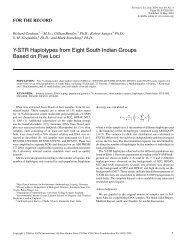MEMES Robert Aunger LSHTM 'Meme' is a ... - Hygiene Central
MEMES Robert Aunger LSHTM 'Meme' is a ... - Hygiene Central
MEMES Robert Aunger LSHTM 'Meme' is a ... - Hygiene Central
You also want an ePaper? Increase the reach of your titles
YUMPU automatically turns print PDFs into web optimized ePapers that Google loves.
1998). Th<strong>is</strong> appears to be sensible, because it <strong>is</strong> quite easy to observe behaviours which are<br />
duplicated: people are expert at mimicry. Further, the imitation of behaviour need not entail<br />
duplication of information in the brain: the behavioural phenotype can be duplicated through<br />
any number of mental processes. In fact, one might argue that brains are just very complex<br />
machines for replicating behaviours and artefacts: just think of people on the factory floor,<br />
repeating behaviour sequences over and over, thereby making copies of machines. In th<strong>is</strong><br />
view, there are no memes in minds, only out in the world. We are not cultural interactors, just<br />
the equivalent of RNA that enables behaviours and artefacts to reproduce time and again.<br />
The difficulty with th<strong>is</strong> position <strong>is</strong> that complex culture, and the kind of rapid cultural<br />
accumulation seen in humans simply can’t be based on behaviour-copying; if it was enough to<br />
watch each other’s behaviour and then mimic it, then chimpanzees and other species would<br />
have developed cumulative culture.{Tomasello et al. 1993} Presumably the design of complex<br />
technology also requires something more than fixing simple elements together in clever<br />
combinations. So technology itself counts against minds being merely the servants of<br />
machinery.<br />
Memes thus appear to be in minds, if they ex<strong>is</strong>t anywhere. But what <strong>is</strong> their role in minds?<br />
Dawkins suggested that memes are ‘mind viruses’ in the sense that they invade minds to use<br />
them for their own purposes, regardless of whether they cause behaviour beneficial to the<br />
meme’s ‘host’. To the extent that a virus <strong>is</strong> defined as a (proto) life-form which appropriates<br />
ex<strong>is</strong>ting machinery for its own purposes, then memes can only be called mind viruses if they<br />
appropriate machinery developed to replicate other kinds of information (D<strong>is</strong>tin 2004: 76). That<br />
<strong>is</strong>, for memes to be mind viruses, there must be mind ‘genes’, the bits of information which the<br />
brain was designed to replicate. But the brain has not evolved primarily to replicate information;<br />
in fact, most organ<strong>is</strong>ms aren’t social and can’t learn from social interaction. Rather brains<br />
evolved to guide the production of adaptive, flexible behavioural responses to evolutionarily<br />
significant problems. (Tooby and Cosmides 1992; Llinas 1999).<br />
Still, parts of the human brain are devoted to communication, a process in which one person<br />
attempts to infer what <strong>is</strong> in the mind of others. Arguably, then, in those species which can learn<br />
socially, something like words might be ‘mind genes’. So either memes do more work than<br />
biological viruses to replicate themselves, because the mind was not designed to replicate bits<br />
of information like them, or memes piggy-back on the lingu<strong>is</strong>tic system. Either way, D<strong>is</strong>tin<br />
(2004) points out that Blackmore (1999) and Dennett (1995) tend to conflate memes-asthoughts<br />
with memes-as-things-to-think-with. She uses the philosophical notion of a<br />
propositional attitude to clarify the d<strong>is</strong>tinction: memes are just information like propositions, but<br />
thoughts can reflect on th<strong>is</strong> information, such that we form attitudes toward that information, like<br />
beliefs or fears or desires. Blackmore and Dennett thus fail to d<strong>is</strong>tingu<strong>is</strong>h between memes and<br />
attitudes towards memes, which leads them to believe that that there <strong>is</strong> nothing to the mind but<br />
a collection of memes (e.g., Dennett 1991:210). From th<strong>is</strong> false proposition, Blackmore and<br />
Dennett draw the incorrect inference that all of culture <strong>is</strong> composed of memes, since memes<br />
are just socially communicated ideas. However, if memes are mind parasites, they must be<br />
thoughts that use independent psychological machinery to get themselves replicated; by<br />
definition, they cannot be all there <strong>is</strong> inside one’s head. The epidemiological view of memes <strong>is</strong><br />
thus incons<strong>is</strong>tent with the claim that the mind <strong>is</strong> a complex of memes and nothing more. In such<br />
a case, we can only think with memes, and not ‘r<strong>is</strong>e above’ them, through metarepresentational<br />
thought which represents our own thoughts to ourselves. There must be<br />
innate structure in the mind prior to social learning which influences which information will be




